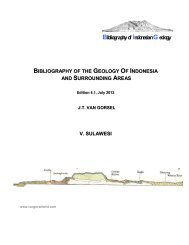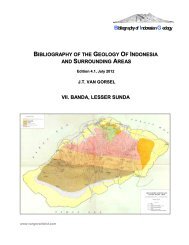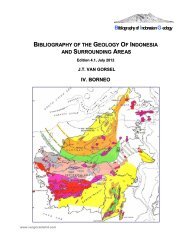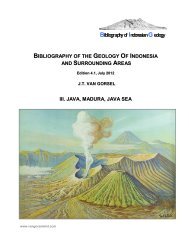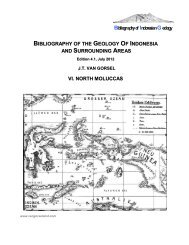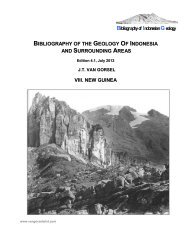Sumatra, Sunda Shelf, Natuna - Bibliography of Indonesia Geology
Sumatra, Sunda Shelf, Natuna - Bibliography of Indonesia Geology
Sumatra, Sunda Shelf, Natuna - Bibliography of Indonesia Geology
Create successful ePaper yourself
Turn your PDF publications into a flip-book with our unique Google optimized e-Paper software.
Triassic tin-granites on Bangka-Belitung. Flysch-type U Jurassic- Lw Cretaceous. M-Late Cretaceous granites<br />
and Kikim Tuffs. Widespread Late Oligocene- earliest Miocene ‘Old Andesite’ along Barisan Range )<br />
Gasparon, M. (1994)- Origin and evolution <strong>of</strong> mafic volcanics <strong>of</strong> <strong>Sumatra</strong> (<strong>Indonesia</strong>): their mantle sources, and<br />
the role <strong>of</strong> subducted oceanic sediments and crustal contamination. Ph.D. Thesis, Univ. <strong>of</strong> Tasmania, p.<br />
Gasparon, M. (2005)- Quaternary volcanicity. In: A.J. Barber, M.J. Crow & J.S. Milsom (eds.) <strong>Sumatra</strong>:<br />
geology, resources and tectonic evolution, Geol. Soc. London, Mem. 31, Chapter 9, p. 120-130.<br />
Gasparon, M. & R. Varne (1995)- <strong>Sumatra</strong>n granitoids and their relationship to Southeast Asian terranes.<br />
Tectonophysics 251, 1-4, p. 277-299.<br />
Geinitz, H.B. (1876)- Zur Geologie von <strong>Sumatra</strong>. Palaeontographica 22, p. 399-404. (also in Jaarboek<br />
Mijnwezen 1878, 1, p. 127-137) ('On the geology <strong>of</strong> <strong>Sumatra</strong>'. One <strong>of</strong> first papers on <strong>Sumatra</strong> West coast<br />
geology, with descriptions <strong>of</strong> fusulinids, brachiopods, etc.. Companion paper by Von der Marck (1876) on<br />
Tertiary fossil fish from region, p. 405-414)<br />
Genrich, J.F., Y. Bock, R. McCaffrey, L. Prawirodirdjo, C.W. Stevens, S.S.O. Puntodewo, C. Subarya, & S.<br />
Wdowinski (2000)- Distribution <strong>of</strong> slip at the northern <strong>Sumatra</strong>n fault system. J. Geophys. Res. 105, p. 28,327-<br />
28,342.<br />
(<strong>Sumatra</strong>n fault in N <strong>Sumatra</strong> (1°S- 3°N) GPS-derived slip rates increase slightly N-ward from 23 mm/yr at<br />
0.8°S to 26 mm/yr at 2.7°N. Banda Aceh embayment is extruded to NW at 5 mm/yr. N part <strong>of</strong> back arc basin is<br />
part <strong>of</strong> rigid <strong>Sunda</strong> <strong>Shelf</strong>, while N forearc is subjected to extension nearly parallel to arc<br />
Gibbons, A. J.M. Whittaker & P. Muller (2010)- Revisiting the magnetic anomalies along the West Australian<br />
margin identifies a new continental fragment that accreted to <strong>Sumatra</strong> during the Early Eocene. American<br />
Geophysical Union, Fall Meeting 2010, Abstract #T13C-2223. (Abstract only)<br />
(Reconstruction <strong>of</strong> abyssal plains along W Australian margin reveals that, apart from Greater India and<br />
Argoland, a third continental block (Gascoyneland) must also have rifted from Australia since Jurassic. From<br />
132 Ma it formed the stretched continental crust <strong>of</strong> Exmouth Plateau and then oceanic crust <strong>of</strong> Gascoyne and<br />
Cuvier abyssal plains. At 115 Ma Gascoyneland began moving N while Greater India continued W.<br />
Gascoyneland would have reached W <strong>Sumatra</strong> at ~60 Ma. Woyla Group, consisting <strong>of</strong> the Sikuleh, Natal and<br />
Bengkulu terranes, alongW coast <strong>of</strong> <strong>Sumatra</strong>, identified as oceanic arc, which accreted in Jurassic-Early<br />
Cretaceous after formation <strong>of</strong> short-lived, narrow marginal seaand may overlie continental crust due to the<br />
presence <strong>of</strong> the Sikuleh granitoid batholith. We propose Gascoyneland now buried beneath Woyla Terrane)<br />
Ginger, D. & K. Fielding (2005)- The petroleum systems and future potential <strong>of</strong> the South <strong>Sumatra</strong> basin. Proc.<br />
30 th Ann. Conv. Indon. Petrol. Assoc., p. 67- 89.<br />
(S <strong>Sumatra</strong> Basin mixed terrigenous, volcaniclastic and carbonate fill. Five main plays: Pre-Tertiary fractured<br />
basement, Oligocene-E Miocene (Lower Talang Akar Fm) fluvio-deltaic sandstones, E Miocene (Batu Raja Fm)<br />
carbonates and E Miocene (Gumai Fm) and M Miocene (Air Benakat Fm) shallow marine sandstones.<br />
Oligocene-E Miocene age lacustrine and deltaic source rocks. Pinch-out <strong>of</strong> Oligocene and Miocene regional<br />
seals limit prospectivity on E side <strong>of</strong> basin. Cumulative oil production >2 BBO, original gas reserves 22 TCF,<br />
with



